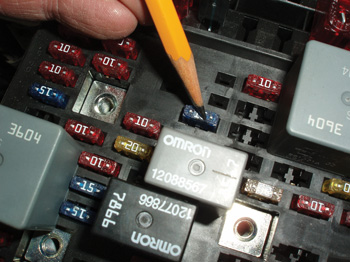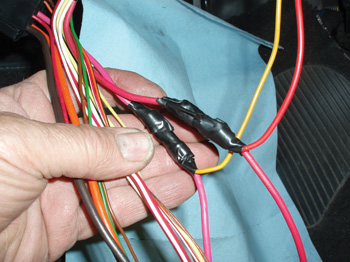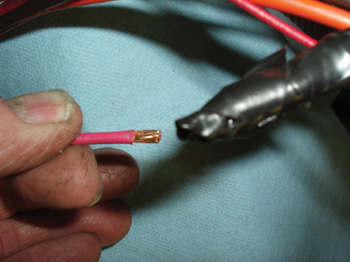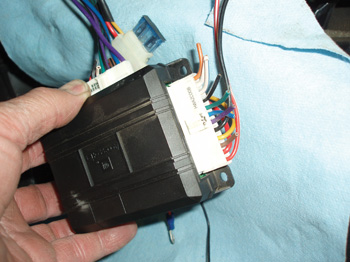 by Gary Goms
by Gary Goms
I’ve been finding myself doing more mobile diagnostic work lately, and I’ll tell you up front that mobile diagnostics aren’t as easy as they might seem simply because the mobile diagnostic tech doesn’t always have complete control over the repair process.
In most cases, the service write-up is pretty sketchy and the service history of the vehicle is unavailable. In the worst-case scenario, repairs have been previously attempted that didn’t solve the problem. To make matters worse, those repairs often insert even more unknowns into the original problem. The easiest cases to solve are the ones in which the technician knows he’s in over his head and calls for help before he gets too deep into the diagnostic process.
The Stranded Visitor
A 2001 Chevrolet Blazer with an intermittent no-code stalling condition aptly illustrates what the mobile diagnostic process can be about. The Blazer was owned by a visitor to our area who had experienced a random stalling condition before leaving home. According to the visitor, she had spent about $1,200 to have the problem repaired before leaving on her trip. The repair order was left at home, so the previous shop’s rationale for installing what we observed as new spark plugs, distributor cap, rotor, wires, EGR valve and alternator wasn’t available. 
Currently, with only about 60,000 miles on the odometer, the vehicle was in excellent condition. Needless to say, after the vehicle was unloaded from the car transport, the engine immediately started and ran perfectly as the vehicle was
driven into the shop.
At this point, I was called to diagnose the random stalling condition because time and money was of the essence, the vehicle was now running perfectly, and the shop in question was looking for a quick solution. I use the term “random” when the condition occurs unpredictably at no regular time interval. Obviously, the stalling problem hadn’t occurred as the customer drove her Blazer across three states to get to her destination. Only after she arrived did the random stalling condition appear once again. According to the customer, the engine would run about 20 minutes before stalling and would restart if she “let the Blazer rest for a while.”
Non-Invasive Testing
When diagnosing random and intermittent failures, never complicate the diagnosis by taking things apart. The problem with disconnecting wiring and bumping parts around is that a tech can temporarily repair a bad connection or inadvertently jiggle a cracked circuit board back into operation.
When the complaint is suddenly “cured,” the tech doesn’t know what he did to “fix” the problem. Worse still, the vehicle may run days and even weeks until changes in heat or humidity or a sudden jolt causes the bad connection or cracked circuit board to fail once again.
Scan tools, without question, provide the most non-invasive method of diagnosing complex operating systems. Using a scan tool to analyze vehicle operating systems allows a diagnostic tech to look inside a system without touching the hood latch or a single part under it. For those very reasons, diagnostics on modern vehicles are scan tool based.
In this case, a diagnostic trouble code P0464 was retrieved, which indicated an intermittent fuel level sensor circuit problem. Rapping on the fuel tank with the key on, engine off made the fuel gauge instantly leap from “empty” to “full” and back to “empty.” So there was obviously a correlation between the trouble code and a failure in the fuel level circuit.
Blue Car Syndrome
According to my experience, many Blazers of this vintage had problems with fuel level sensors. Because the fuel gauge and fuel pump share the same connector and the same module, it’s not unusual for a failed fuel level sensor to precede a failed fuel pump. This type of failure pattern is, according to my experience, relatively common with many General Motors trucks because these vehicles experience problems with the fuel module connector and the module itself.
Pattern failures like this lead to what is popularly known as “Blue Car Syndrome,” which (tongue in cheek) means if replacing a fuel pump module fixed a Blue Car with this particular set of failure symptoms, then a fuel pump replacement should fix the next Blue Car with a similar set of symptoms. As we shall see in the following text, it’s really easy to fall victim to Blue Car Syndrome.
Have You Had a Case of Blue Car Syndrome?
Blue Car Syndrome is the non-technical term for a very common phenomenon. It is the experience that many people possess regarding having a specific observation, idea, experience, etc., enter one’s consciousness, and then having it seem that the same observation or experience begins to occur with increased frequency.
For example, when one buys a blue car, and then suddenly, they are “seeing blue cars everywhere.” A good explanation is that the person rarely paid much notice to the experience until it became personalized. While blue cars are common on the roads and until that person bought one, the phenomenon of “blue cars everywhere” didn’t register.
Once again, another person falls victim to the Blue Car Syndrome.
Vortec Fuel Systems
To better understand my experience with Blue Car Syndrome, let’s review how the GM Vortec fuel system works. The Vortec injector supplies fuel to a poppet valve located at the end of a plastic tube positioned in the intake port. At least 45 psi fuel pressure is required to force the poppet valve open. According to my experience, unless fuel pressure exceeds 50 psi, the poppet valve either won’t open or the limited fuel supplied to the cylinder won’t support combustion.
In a word, Vortec systems are very sensitive to reductions in fuel pressure and volume. If fuel volume and pressure are marginal, the poppet valves close and the engine will immediately stall. In short, whereas many conventional systems tend to keep the engine running in a lean condition, the Vortec system simply quits.
Fuel Pump Diagnostics
At this point, I was convinced that the stalling complaint was related to fuel pump performance for several reasons. First, my Blue Car experience associated fuel level sensor trouble codes with fuel pump failures.
Second, General Motors has had failure problems with the fuel pump module connector. Third, this wouldn’t be the first Chevy Blazer that I’ve seen with the fuel pump failing at 60,000 miles.
But at present, the engine had run for at least an hour without stalling. During that time, we checked the charging system and determined that the battery was weak and that an in-tank problem existed with the fuel gauge. Because rapping on the fuel tank never produced a stall, our next step was to test fuel pressure and volume. After attaching the gauge and finding a suitable reservoir for volume testing, we turned the key on only to discover that we had no fuel pressure whatsoever.
Cycling the ignition key on-off didn’t momentarily activate the fuel pump as it should. Moreover, the fuel pump relay located in the underhood fuse and relay box didn’t click as the key was turned on. Because using the bidirectional control in the scan tool didn’t activate the fuel pump relay, it was time to get down to some serious diagnostics.
Data Stream Analysis
According to the wiring schematic, the fuel pump relay wasn’t receiving voltage from the ignition switch. Some careful observation provided some additional clues. First, I observed that the voltmeter located in the instrument cluster showed zero volts, key on, engine off. Second, the system voltage PID on the scan tool data stream confirmed zero key-on volts.
Here again, General Motors had some “Blue Car” pattern failures with ignition switches on its full-size pickup trucks. On the other hand, I hadn’t recalled of any major ignition switch issues on smaller chassis like the Chevy Blazer.
I’ve learned the hard way that it’s important to test each fuse contained in the underhood and instrument panel fuse boxes simply because finding one or more fuses blown or without power usually helps indicate which circuit is failing. All of the Blazer’s fuses tested perfectly except ECM #1 fuse, which had no source voltage. A wiring schematic indicated that the ECM #1 fuse was powered by the ignition switch. See Photo 1. 
Our next step was to lift the underhood fuse box to check the wiring for rodent damage. In our area at least, the box-like design of the GM fuse box serves very well as a rodent hotel. Unfortunately, rodents like field mice become very adept at nipping many of the smaller-gauge wires in two if those wires happen to be in the way of nesting. A thorough inspection of the fuse box confirmed that the wiring was intact.
Back to the Ignition Switch
The ECM #1 fuse is supplied voltage through a pink wire connecting the ignition switch to the B+ fuse holder. Going back to pattern failure or “Blue Car” diagnostics, it seemed reasonable to assume that the ignition switch was the root cause of the intermittent stalling complaint. But the only problem I had with that scenario was that a bad ignition switch normally responds to a few sharp raps on the steering wheel with the palm of the hand, which this switch didn’t.
Nevertheless, the first real disassembly in my diagnostic strategy was to have the technician remove the steering mast jacket so we could inspect the pink wire connecting the switch to the fuse holder. Removing the lower dash panel revealed why ECM #1 fuse lost voltage. See Photo 2.
Taped connections always bother me. After removing the tape, we discovered a butt connector being used to splice another wire into the ECM #1 fuse circuit. All that was holding the wire into the butt connector was the tape wrapped around the wire splice. See Photo 3.
In this case, the person didn’t use a good crimping tool to secure the splice. Crimping a connector with side cutters or pliers simply doesn’t work.
The extra wire was used to power a module with the GM logo and a General Motors part number molded into its case. Note from Photo 4 that the module has the majority of wires cut away. Obviously, this module is an optional component that was installed after the vehicle was purchased. Although I’m sure a call to our local Chevy dealer would have identified the module, we didn’t have time to do anything except leave the wire disconnected and verify all other vehicle functions.
Because the owner was running out of vacation time, and because the steering mast cover had already been removed, we decided to replace the ignition switch simply because we couldn’t discount the switch as the root cause of the stalling complaint. We advised the Blazer’s owner that the battery should be replaced when she could afford it. We also noted on the repair order that the fuel pump should be again tested if a future driveability problem was experienced.
Blue Car Syndrome Summary
Random and intermittent failures continue to be Diagnostic Dilemmas for driveability technicians. In this case, we began by using a scan tool to analyze the system in a non-invasive manner. The Blue Car Syndrome came into play when the fuel sensor circuit code was retrieved. At that time, I would have bet money on the fuel pump. But, in this case persistence paid off because we ran the engine until the stalling complaint occurred. At that point, we tested all fuses for voltage continuity and found ECM #1 fuse without battery voltage. The underhood fuse box wiring also passed inspection.
Here again, the Blue Car Syndrome took effect because I decided we should take a close look at the ignition switch. After removing the mast jacket and instrument panel bolster, we discovered the poorly executed wire splice. In all, we spent about an hour diagnosing a problem that another shop had missed. In that sense, applying the Blue Car Syndrome to the problem led to a somewhat lucky, but also accurate diagnosis.













